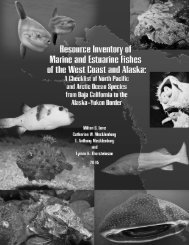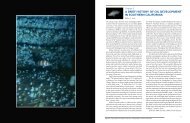Reproductive Ecology and Body Burden of Resident ... - The Love Lab
Reproductive Ecology and Body Burden of Resident ... - The Love Lab
Reproductive Ecology and Body Burden of Resident ... - The Love Lab
Create successful ePaper yourself
Turn your PDF publications into a flip-book with our unique Google optimized e-Paper software.
Task 2: Otolith Elemental Signatures <strong>of</strong> Kelp Rockfish (Sebastes atrovirens)<br />
<strong>and</strong> Pacific S<strong>and</strong>dab (Citharichthys sordidus) from Offshore Oil Platforms<br />
<strong>and</strong> Natural Areas in the Southern California Bight<br />
Mary M. Nishimoto <strong>and</strong> Milton S. <strong>Love</strong><br />
Abstract<br />
<strong>The</strong> goal <strong>of</strong> this study was to determine if fishes, residing in the mid-water habitat or bottom habitat<br />
<strong>of</strong> platforms, possess unique otolith microchemical signatures. <strong>The</strong> specific objectives <strong>of</strong> this study were:<br />
1) to determine if otolith microchemistry can be used to distinguish fishes that reside at platforms from<br />
those that reside at natural habitat; <strong>and</strong> 2) determine whether otolith chemistry is related to the water chemistry<br />
<strong>of</strong> the environment where fishes reside. We sampled 98 kelp rockfish <strong>and</strong> 108 Pacific s<strong>and</strong>dab collected<br />
from six <strong>of</strong>fshore oil platforms <strong>and</strong> 12 natural areas during 2005 <strong>and</strong> 2006 for microchemical analysis <strong>of</strong><br />
19 elements in otoliths. <strong>The</strong> otolith composition <strong>of</strong> kelp rockfish <strong>and</strong> Pacific s<strong>and</strong>dab differed between the<br />
two habitat types—the sampled platforms <strong>and</strong> natural sites—<strong>and</strong> among geographic areas. Kelp rockfish<br />
collected from platforms tended to incorporate higher concentrations <strong>of</strong> Mg <strong>and</strong> Ba <strong>and</strong> lower concentration<br />
<strong>of</strong> Sr in otoliths compared to fish from natural habitat. In comparison, Pacific s<strong>and</strong>dab collected from<br />
platforms tended to have lower concentrations <strong>of</strong> Ba <strong>and</strong> Fe in otoliths compared to fish from natural<br />
habitat. Sr Ca -1 in otoliths <strong>of</strong> kelp rockfish tended to decrease eastward along the coastal shelf from Point<br />
Conception through the east Channel. Mn Ca -1 in otoliths <strong>of</strong> s<strong>and</strong>dab from both habitat types was lower<br />
in the three westernmost geographic areas (Point Conception, west Santa Barbara, <strong>and</strong> east Santa Barbara)<br />
than in the eastern <strong>and</strong> southern areas (east channel entrance, <strong>of</strong>fshore east channel, <strong>and</strong> Southern California<br />
Bight). Mn Ca -1 was not detectable in kelp rockfish otoliths. <strong>The</strong> success rate <strong>of</strong> correctly assigning<br />
fish to habitat type (platform or natural habitat) using a canonical discriminant function based on otolith<br />
element signatures differed between species. Ninety-four percent <strong>of</strong> kelp rockfish individuals were correctly<br />
assigned to habitat type based on the otolith signature <strong>of</strong> Mg Ca -1 , Ba Ca -1 , <strong>and</strong> Sr Ca -1 . A lower proportion,<br />
64%, <strong>of</strong> Pacific s<strong>and</strong>dab correctly grouped into habitat type based on the otolith signature <strong>of</strong> Mg Ca -1 , Sr Ca -<br />
1<br />
, Mn Ca -1 , Cu Ca -1 , <strong>and</strong> Ba Ca -1 —otolith element concentrations that individually varied between s<strong>and</strong>dab<br />
habitat types <strong>and</strong>/or areas. Success in discriminating otoliths <strong>of</strong> either species from the two different habitat<br />
types was not associated with seawater element concentrations. Results from this study imply that platform<br />
habitat “fingerprints,” unique microchemical markers, may be identifiable in kelp rockfish (although not<br />
for Pacific s<strong>and</strong>dab) along the time-keeping, growth trajectory <strong>of</strong> the otolith to reconstruct the history <strong>of</strong><br />
platform habitat use during the lifetime <strong>of</strong> individuals. Such reconstructions will require more study on the<br />
spatial variability <strong>of</strong> platform elemental signatures from all existing platforms <strong>and</strong> the temporal stability <strong>of</strong><br />
platform markers.<br />
33




